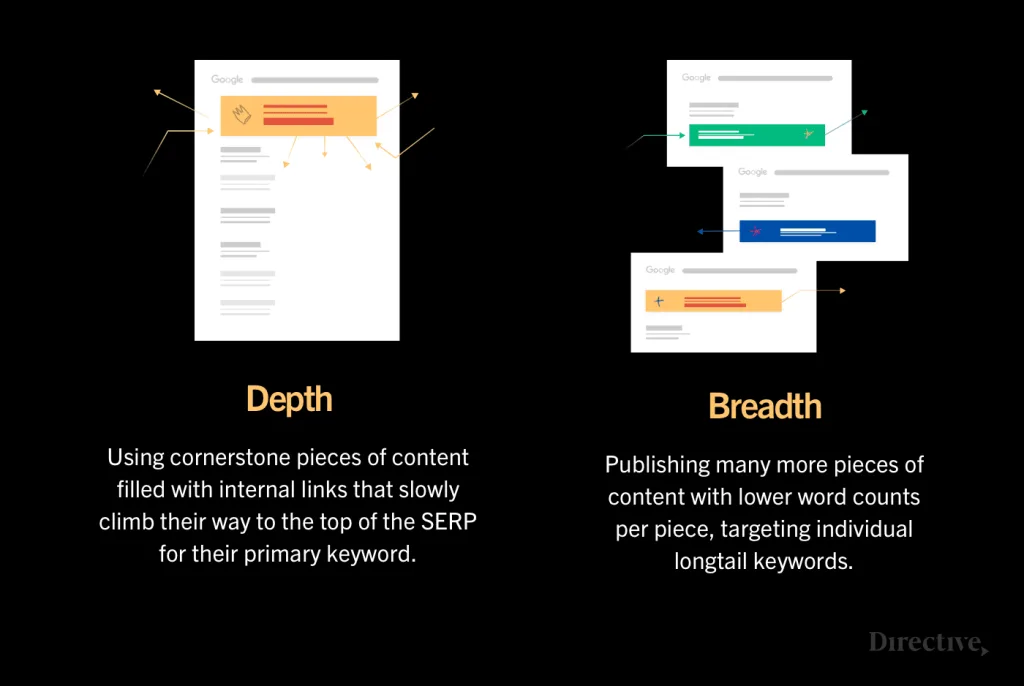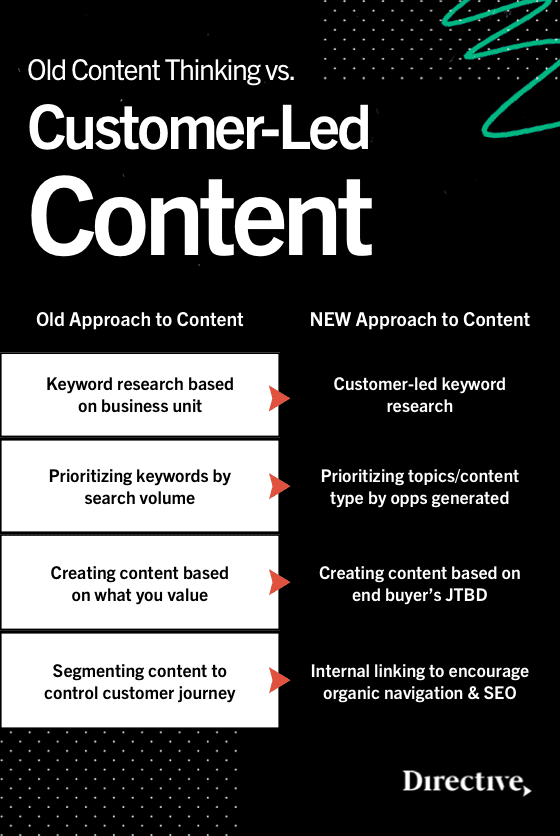Making a name for yourself in the overly saturated SaaS content marketing world can be a tough racket. With all the different news outlets, industry influencers, blogs, webinars, martech updates, and the like, it’s most definitely a competition to actually distinguish your content.
If you boil down content marketing to its core value props – what it’s meant to do in the bigger SEO picture – you have a singular goal: drive more organic traffic. Now, again keeping things simple, content marketers often go about this one of two different ways. And it’s a debate that we’ve heard many times before: breadth versus depth.
Depth: Some content marketers choose to create massive, cornerstone pieces of content filled with internal links that will slowly but steadily climb their way to the top of page 1 for their primary keyword.
Breadth: Other SaaS marketers might choose to target the individual longtail keywords themselves, publishing many more pieces of content but with lower word counts per piece.

Now, both of these strategies have their benefits. But only one includes creating a new system on which to support a mass content push. And, as is the case with any truly LTV:CAC guided business unit, scaling is never as easy as it sounds.
Why Scale Your Content Marketing Efforts
Knowing where your customers are actually discovering your brand is key to the success of any marketing strategy. And if you’re in the service based industry like – or something like it *coughcoughSaaScoughcough* – you already know that your customers are often combing through Google for the right answer to their specific SaaS question.
Organic SaaS marketing strategies like customer-led content marketing are certainly not the fastest in terms of generating ROI. But more often than not they end up generating the highest quality leads and highest LTVs.
If you know how to properly craft your content around the right JTBD (jobs to be done) for the right contacts at your ideal companies, you’d be amazed what kind of leads can come through a simple blog post.

Trouble Scaling Content?
Once you start to see the returns that SEO and customer-led SaaS content marketing can drive for your business, it’s only a matter of time before you want to double down. But keep in mind:
Scaling content isn’t like scaling ads. You don’t get to increase the budget and watch impressions or clicks increase. Unlike platform based ad campaigns (however customized they may be) scaling content means scaling the hours you invest in your content creation more than anything else.
Now, I hate to break it to you. But “scaling the hours you invest in your content creation” doesn’t equate to simply hiring more freelance writers. If it were that simple, platforms like Writerly, Writeracces, and the like would dominate the entire digital marketplace. Last I checked, they were still fighting the good fight like the rest of us.
5 Bottlenecks To Scaling Content That You Aren't Seeing
To scale content, you need to scale writing resources. We all know that – and hopefully you don’t need a blog post to tell you so. Instead, to help you scale your content with a bit more grace and a bit less grit – here are the 5 major bottlenecks to scaling content (other than just the writing) that you need to consider.
1. Keyword Research Limitations
Before you even start to scale the actual content production for your big publication push, you’ll need to scale your research first. This goes beyond just brainstorming topics to fill a massive spreadsheet.
To make all this effort worthwhile, you’ll have to prioritize your keywords based on business unit, audience, search volume, and potentially even conversion and close rates. You’ll also have to make sure that you take into consideration the time it will take to research and outline each of the pieces you plan to publish. Especially as you start to scaling into the triple digits, it’s going to be key that your team knows how to search every nook and cranny to find every last longtail keyword available for you to write on.
What does all this mean? Well it means 2 things really:
- You’re going to have to scale and or front-load your content research to properly supply your writers with topics and outlines before hand.
- You need to timeline how long you’ll be able to maintain a scaled keyword-driven content strategy at scale. Or, at the very least, figure out a way to source topics beyond your brand’s primary keywords once the well runs dry.
2. Editorial Standards, Processes, And QC
Just because you’ve chosen the breath over depth approach does not mean you should embrace a quantity over quality mindset. You’re going to have to build out an editorial and QC system, preferably with separate parties responsible for actual copy editing and high-level conceptual revisions. This means that as you start to hire more freelancers, you’re also going to have to hire editors.
3. Design Turnaround Times
Now unless you’re working with a very formal and news/data driven audience that doesn’t like images, design is going to be a much bigger factor in scaling your content than you’d first imagine.
Most marketers really don’t have a strong grasp on design as a practical day-to-day workflow. It’s a blackbox that many of us take for granted, often scaling out marketing initiatives without considering what design will have to create and how fast they’ll have to do it.
– Candid Confession of a 6-year Marketing Manager
You don’t want your designers drowning in content marketing designs, nor do you want the quality of their work to plummet from an overloaded scheduling.
Computing the design needs into your content calendar is just as important remembering to account for editorial QC. If not as important, even more so. Because, unlike editing, you yourself can’t simply take that on in extra hours with some coffee and motivational music. This is where hiring enough designers to help you scale (without savagery) is vital. Not only that, but establishing editorial standards and caps for design work can also help maintain some regularity in task delegation.
4. Juggling A Hectic Content Calendar
Speaking of task delegation, where are you actually going to schedule and manage all of these different pieces of content you plan to publish? If you’re working with more than 1 piece being published a day, your content calendar needs to be more comprehensive than simply what’s being pushed live. Managing content and scale isn’t just managing the publication calendar – it’s about managing the entire editorial process before each piece goes live.
This is where scheduling becomes so hectic.
As an editor or editor-in-chief, you need to receive pieces weeks before they go live in order to edit, revise, assign design assets, collect and assemble the final piece, and publish it. Which means that you need to have a content calendar that not only lives a week or so in the future, but also accounts for the different turnarounds and lagtimes of your individual writers and projects.
All hail the mighty Asana subtask…am I right?

5. And Obviously…The Writing Itself
And of course, I won’t leave you without discussing how to scale the actual writing aspect of your content initiative.
In order to ensure that you don’t bottleneck your content calendar and publication queue, it will most likely be necessary to hire some extra writers to help you scale. But knowing how many to hire and how many pieces to ask of them at what pace is a dicey calculation for any Director to handle.
Here’s a few numbers that might help you out:
As a general rule, capping writers around the 10K weekly wordcount seems to be appropriate. Keep in mind this is for full time writers, dedicated to pounding keys for you most of the day. And this is at their capacity, where turn around times will start to get tight and quality might start to decline.
Now, this is only an average number, and you will hopefully find writers who can push that number up to 15K or higher. But this isn’t something you can rely on at scale. Finding the right mix of writers and understanding what you can get out of each individual’s wordcount and hourly workload is how you’ll eventually create the optimal budget for your content initiative.
Beating The Hidden Time Sinks Of SaaS Content Marketing
In the end scaling your content isn’t so much about writing more blog posts. It’s about finding the hidden time sinks that limit your current publication queue, and providing the proper resources in order to fix these common content marketing bottlenecks.
Now, you might be wondering how you can invest in something such a large team from something a strategy that doesn’t generate quality leads or fast enough returns? Well, I’ll answer your question with another one of my own: Are you creating content for Google, or are you creating content for the people who actually pay your bills – your customers?
If you’re scaling an old demand gen content strategy and hoping more posts will equal more MQLs and revenue, you can keep your fingers crossed. But if you’re scaling a truly customer-led content strategy built on the needs of your audience – it’s time to double down.
Join A Slack Community Dedicated to SaaS Marketing